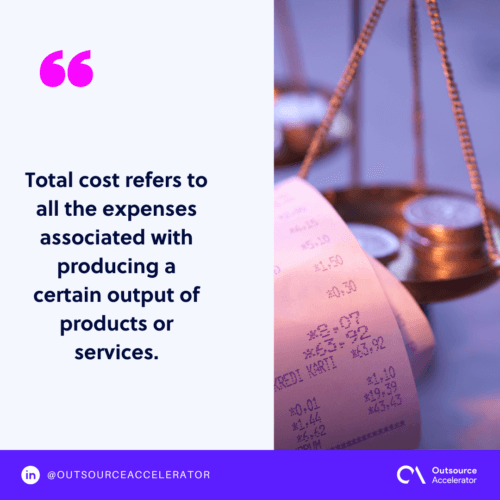Total cost
Definition
What is the total cost?
Total cost refers to all the expenses associated with producing a certain output of products or services.
Total costs are an economic measure of the total price paid to manufacture goods. It is made up of variable costs and fixed costs.
It’s important to note that the meaning of total cost may change considerably depending on the context. When used to describe production costs, for example, it assesses the total fixed, variable, and overhead charges involved with manufacturing goods.
This is an important topic for entrepreneurs and executives to understand since it helps them track the whole cost of their operations. It is also often used by the management when deciding on operating expenses.
Investors, on the other hand, look at it to determine the funds required to make an investment as well as the opportunity costs involved with choosing one investment over another.
To be successful, business owners must have a clear understanding of how to generate profit. They must calculate several elements in their accounts like total cost.

What is the total cost formula?
To calculate the total cost, you only need to combine the average fixed cost and average variable cost and multiple the result by the number of units or output.
Total cost = (Average fixed cost + Average variable cost) x Number of units
Fixed costs are company expenses that remain constant regardless of the number of items produced.
These include monthly bills like rent, insurance, payroll taxes, office supplies, and compensation for employees who are not directly involved in manufacturing the products.
Those that change based on the number of products produced or consumers who want the service are considered the variable costs.
Materials needed in manufacturing, packing and delivery, expenses of the products, acquisition, hiring, and repair of manufacturing equipment are examples of variable costs.
How total cost works
The total cost formula works by assigning all business costs to the products or services being offered.
By calculating business expenditures and dividing them by the organization’s unit production, it is possible to determine how profitable the company is and find diversification options that may enhance profits.
Businesses also use total cost estimations to assess their efficiency and find areas where they may save money on both variable and fixed costs.
This might imply sourcing goods from a lower-cost source or transferring to a facility with cheaper rent to reduce variable expenses.
The total cost may also be used to identify lines that are underperforming and should be eliminated or modified to make them more profitable.







 Independent
Independent




